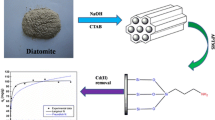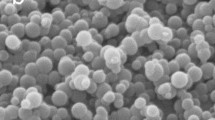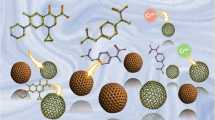Abstract
A simple sol-gel method and external gelatinization method of hollow alumina spheres synthesis were developed in this study. The spheres were modified with polyethyleneimine (PEI) producing PEI-Al2O3 via (3-glycidyloxypropyl)trimethoxy-silane, GLYMO, linker. Characterization results, obtained using XRD and SEM microscopy revealed spherical geometry with a hollow core of PEI-Al2O3 adsorbent. Introduction of a large number of the amino group, 6.9 mmol g−1, contributes to achieving high adsorption capacities, qm, of 95.6, 124.9, 61.3, and 125.9 mg g−1 for Cd2+, Pb2+, As(V), and DCF, respectively, which is obtained by using the Langmuir model. Thermodynamic studies indicated feasible adsorption and higher spontaneity with temperature increase. The kinetic study conveniently modeled using pseudo-second-order (PSO) and Weber-Morris kinetic model, as well as single resistance mass transfer model, indicated a change of the contribution of diffusional processes during adsorption with a dominance of intra-particle diffusion. The fixed-bed column adsorption data, fitted using Bohart-Adams, Clark, Yoon-Nelson, and Thomas models, showed lower capacity in comparison to batch study, and thus clear potential applicability of PEI-Al2O3 was deduced even at a high loading of feed water.





Similar content being viewed by others
Data availability
Not applicable.
References
Agarwal S, Tyagi I, Gupta VK, Dehghani MH, Jaafari J, Balarak D, M. Asif (2016) Rapid removal of noxious nickel (II) using novel γ-alumina nanoparticles and multiwalled carbon nanotubes: kinetic and isotherm studies. J Mol Liq 224:618–623. https://doi.org/10.1016/j.molliq.2016.10.032
Arrhenius S (1889) Über die Dissociationswärme und den Einfluss der Temperatur auf den Dissociationsgrad der Elektrolyte. Z Phys Chem 4:96–116. https://doi.org/10.1515/zpch-1889-0408
Bertling J, Blömer J, Kümmel R (2004) Hollow microspheres. Chem Eng Technol 27:829–837. https://doi.org/10.1002/ceat.200406138
Bhat A, Megeri GB, Thomas C, Bhargava H, Jeevitha C, Chandrashekar S, Madhu GM (2015) Adsorption and optimization studies of lead from aqueous solution using γ-Alumina. J Environ Chem Eng 3:30–39. https://doi.org/10.1016/j.jece.2014.11.014
Boyd GE, Adamson AW, Myers LS (1947) The exchange adsorption of ions from aqueous solutions by organic zeolites. II. Kinetics. J Am Chem Soc 69:2836–2848. https://doi.org/10.1021/ja01203a066
Buffle J, Zhang Z, Startchev K (2007) Metal flux and dynamic speciation at (Bio)interfaces. Part I: Critical evaluation and compilation of physicochemical parameters for complexes with simple ligands and fulvic/humic substances. Environ Sci Technol 41:7609–7620. https://doi.org/10.1021/es070702p
Bugarčić MD, Milivojević M, Marinković A et al (2018) Application of raw volcanic rock found in Etna valley as an adsorbent of chromates, arsenates and selenates. Metall Mater Eng 24:133–144. https://doi.org/10.30544/366
Chen B, Zhao X, Liu Y, Xu B, Pan X (2015) Highly stable and covalently functionalized magnetic nanoparticles by polyethyleneimine for Cr(vi) adsorption in aqueous solution. RSC Adv 5:1398–1405. https://doi.org/10.1039/c4ra10602d
Chu KH (2010) Fixed bed sorption: Setting the record straight on the Bohart-Adams and Thomas models. J Hazard Mater 177:1006–1012. https://doi.org/10.1016/j.jhazmat.2010.01.019
Cochran JK (1998) Ceramic hollow spheres and their applications. Curr Opin Solid State Mater Sci 3:474–479. https://doi.org/10.1016/S1359-0286(98)80010-7
D’Souza L, Devi P, Divya Shridhar MP, Naik CG (2008) Use of Fourier Transform Infrared (FTIR) spectroscopy to study cadmium-induced changes in Padina tetrastromatica (Hauck). Anal Chem Insights 2008:135–143. https://doi.org/10.4137/117739010800300001
Damoah LNW, Zhang L (2011) AlF3 reactive Al2O3 foam filter for the removal of dissolved impurities from molten aluminum: Preliminary results. Acta Mater 59:896–913. https://doi.org/10.1016/j.actamat.2010.09.064
de Faria CLL, de Oliveira TKR, dos Santos VL et al (2009) Usage of the sol-gel process on the fabrication of macroporous adsorbent activated-gamma alumina spheres. Microporous Mesoporous Mater 120:228–238. https://doi.org/10.1016/j.micromeso.2008.11.008
Deng ZY, Fukasawa T, Ando M, Zhang GJ, Ohji T (2001) Microstructure and mechanical properties of porous alumina ceramics fabricated by the decomposition of aluminum hydroxide. J Am Ceram Soc 84:2638–2644. https://doi.org/10.1111/j.1151-2916.2001.tb01065.x
Doke KM, Khan EM (2013) Adsorption thermodynamics to clean up wastewater; critical review. Rev Environ Sci Biotechnol 12:25–44. https://doi.org/10.1007/s11157-012-9273-z
Drah A, Tomić NZ, Veličić Z, Marinković AD, Radovanović Ž, Veličković Z, Jančić-Heinemann R (2017) Highly ordered macroporous γ-alumina prepared by a modified sol-gel method with a PMMA microsphere template for enhanced Pb2+, Ni2+ and Cd2+ removal. Ceram Int 43:13817–13827. https://doi.org/10.1016/j.ceramint.2017.07.102
Einollahi Peer F, Bahramifar N, Younesi H (2018) Removal of Cd (II), Pb (II) and Cu (II) ions from aqueous solution by polyamidoamine dendrimer grafted magnetic graphene oxide nanosheets. J Taiwan Inst Chem Eng 87:225–240. https://doi.org/10.1016/j.jtice.2018.03.039
Feret FR, Roy D, Boulanger C (2000) Determination of alpha and beta alumina in ceramic alumina by X-ray diffraction. Spectrochim Acta B At Spectrosc 55:1051–1061. https://doi.org/10.1016/S0584-8547(00)00225-1
Glasstone S, Laidler KJ, Eyring H (1941) The Theory of Rate Processes, First. McGraw-Hill Inc
Hadi P, Barford J, McKay G (2013) Synergistic effect in the simultaneous removal of binary cobalt-nickel heavy metals from effluents by a novel e-waste-derived material. Chem Eng J 228:140–146. https://doi.org/10.1016/j.cej.2013.04.086
Hua M, Zhang S, Pan B, Zhang W, Lv L, Zhang Q (2012) Heavy metal removal from water/wastewater by nanosized metal oxides: A review. J Hazard Mater 211–212:317–331. https://doi.org/10.1016/j.jhazmat.2011.10.016
Inglezakis VJ, Zorpas AA (2012) Heat of adsorption, adsorption energy and activation energy in adsorption and ion exchange systems. Desalin Water Treat 39:149–157. https://doi.org/10.1080/19443994.2012.669169
Jia Y, Wang R, Fane AG (2006) Atrazine adsorption from aqueous solution using powdered activated carbon - Improved mass transfer by air bubbling agitation. Chem Eng J 116:53–59. https://doi.org/10.1016/j.cej.2005.10.014
Kango S, Kalia S, Celli A, Njuguna J, Habibi Y, Kumar R (2013) Surface modification of inorganic nanoparticles for development of organic-inorganic nanocomposites—a review. Prog Polym Sci 38:1232–1261. https://doi.org/10.1016/j.progpolymsci.2013.02.003
Kojdecki MA, Bastida J, De La Torre FJ et al (2016) Crystalline microstructure of corundum fillers determined from powder X-ray diffraction patterns. Acta Phys Pol A 130:1000–1003. https://doi.org/10.12693/APhysPolA.130.1000
Košević M, Stopic S, Cvetković V, Schroeder M, Stevanović J, Panić V, Friedrich B (2019) Mixed RuO 2 /TiO 2 uniform microspheres synthesized by low-temperature ultrasonic spray pyrolysis and their advanced electrochemical performances. Appl Surf Sci 464:1–9. https://doi.org/10.1016/j.apsusc.2018.09.066
Kumar PR, Swathanthra PA, Rao VVB, Rao SRM (2014) Adsorption of cadmium and zinc ions from aqueous solution using low cost adsorbents. J Appl Sci 14:1372–1378. https://doi.org/10.3923/jas.2014.1372.1378
Li DY, Lin YS, Li YC, Shieh DL, Lin JL (2008) Synthesis of mesoporous pseudoboehmite and alumina templated with 1-hexadecyl-2,3-dimethyl-imidazolium chloride. Microporous Mesoporous Mater 108:276–282. https://doi.org/10.1016/j.micromeso.2007.04.009
Li M, Li MY, Feng CG, Zeng QX (2014) Preparation and characterization of multi-carboxyl-functionalized silica gel for removal of Cu (II), Cd (II), Ni (II) and Zn (II) from aqueous solution. Appl Surf Sci 314:1063–1069. https://doi.org/10.1016/j.apsusc.2014.06.038
Liu C, Shih K, Gao Y, Li F, Wei L (2012) Dechlorinating transformation of propachlor through nucleophilic substitution by dithionite on the surface of alumina. J Soils Sediments 12:724–733. https://doi.org/10.1007/s11368-012-0506-0
Long W, Ting’an Z, Guozhi L et al (2016) Research on activated alumina obtained by spray pyrolysis method. TMS Light Met:103–106. https://doi.org/10.1007/978-3-319-48251-4_18
Lopes CB, Pereira E, Lin Z, Pato P, Otero M, Silva CM, Rocha J, Duarte AC (2011) Fixed-bed removal of Hg2+ from contaminated water by microporous titanosilicate ETS-4: Experimental and theoretical breakthrough curves. Microporous Mesoporous Mater 145:32–40. https://doi.org/10.1016/j.micromeso.2011.04.019
Macêdo MIF, Bertran CA, Osawa CC (2007) Kinetics of the γ → α-alumina phase transformation by quantitative X-ray diffraction. J Mater Sci 42:2830–2836. https://doi.org/10.1007/s10853-006-1364-1
Mahdavi S, Jalali M, Afkhami A (2014) Heavy metals removal from aqueous solutions by Al2O3 nanoparticles modified with natural and chemical modifiers. Clean Techn Environ Policy 17:85–102. https://doi.org/10.1007/s10098-014-0764-1
Maitani Y, Sato H, Nagai T (1995) Effect of ethanol on the true diffusion coefficient of diclofenac and its sodium salt in silicone membrane. Int J Pharm 113:165–174. https://doi.org/10.1016/0378-5173(94)00192-8
Mallakpour S, Madani M (2015) A review of current coupling agents for modification of metal oxide nanoparticles. Prog Org Coat 86:194–207. https://doi.org/10.1016/j.porgcoat.2015.05.023
Niesz K, Yang P, Somorjai GA (2005) Sol-gel synthesis of ordered mesoporous alumina. Chem Commun:1986–1987. https://doi.org/10.1039/b419249d
Nor MAAM, Akil HM, Ahmad ZA (2009) The effect of polymeric template density and solid loading on the properties of ceramic foam. Sci Sinter 41:319–327. https://doi.org/10.2298/SOS0903319N
Organisation for Economic Co-operation and Development (2004) OECD Environmental Data/Données OCDE sur l’environnement. Organisation for Economic Co-operation and Development (OECD), Paris
Pantić K, Bajić ZJ, Veličković ZS, Nešić JZ, Đolić MB, Tomić NZ, Marinković AD (2019) Arsenic removal by copper-impregnated natural mineral tufa part II: a kinetics and column adsorption study. Environ Sci Pollut Res 26:24143–24161. https://doi.org/10.1007/s11356-019-05547-7
Papelis C, Roberts PV, Leckie JO (1995) Modeling the rate of cadmium and selenite adsorption on micro- and mesoporous transition aluminas. Environ Sci Technol 29:1099–1108. https://doi.org/10.1021/es00004a032
Pedretti A, Villa L, Vistoli G (2004) VEGA - An open platform to develop chemo-bio-informatics applications, using plug-in architecture and script programming. J Comput Aided Mol Des 18:167–173. https://doi.org/10.1023/B:JCAM.0000035186.90683.f2
Pillewan P, Mukherjee S, Roychowdhury T, Das S, Bansiwal A, Rayalu S (2011) Removal of As(III) and As(V) from water by copper oxide incorporated mesoporous alumina. J Hazard Mater 186:367–375. https://doi.org/10.1016/j.jhazmat.2010.11.008
Plohl O, Finšgar M, Gyergyek S, Ajdnik U, Ban I, Fras Zemljič L (2019) Efficient copper removal from an aqueous anvironment using a novel and hybrid nanoadsorbent based on derived-polyethyleneimine linked to silica magnetic nanocomposites. Nanomaterials 9. https://doi.org/10.3390/nano9020209
Popović A, Rusmirović J, Radovanović Ž, et al (2019) Novel method of optimized synthesis of an efficient adsorbent based on vinyl modified lignin for cadmium (II) removal. In: Nikolić Z, Milivojević J, Stević Z, et al. (eds) Processing ’19. Society for Process Engineering within SMEITS, Belgrade, pp 195–201
Reichenberg D (1953) Properties of ion-exchange resins in relation to their structure. III. Kinetics of Exchange. J Am Chem Soc 75:589–597. https://doi.org/10.1021/ja01099a022
Ren Y, Yan N, Wen Q, Fan Z, Wei T, Zhang M, Ma J (2011) Graphene/δ-MnO2 composite as adsorbent for the removal of nickel ions from wastewater. Chem Eng J 175:1–7. https://doi.org/10.1016/j.cej.2010.08.010
Sifontes ÁB, Gutierrez B, Mónaco A, Yanez A, Díaz Y, Méndez FJ, Llovera L, Cañizales E, Brito JL (2014) Preparation of functionalized porous nano-γ-Al2O3 powders employing colophony extract. Biotechnol Rep 4:21–29. https://doi.org/10.1016/j.btre.2014.07.001
Šljivić Ivanovic M, Smičiklas I, Pejanović S (2013) Analysis and comparison of mass transfer phenomena related to Cu2+ sorption by hydroxyapatite and zeolite. Chem Eng J 223:833–843. https://doi.org/10.1016/j.cej.2013.03.034
Sobiesiak M, Podkościelna B, Sevastyanova O (2017) Thermal degradation behavior of lignin-modified porous styrene-divinylbenzene and styrene-bisphenol A glycerolate diacrylate copolymer microspheres. J Anal Appl Pyrolysis 123:364–375. https://doi.org/10.1016/j.jaap.2016.11.007
Sokić M, Kamberović Ž, Nikolić V et al (2015) Kinetics of NiO and NiCl2 hydrogen reduction as precursors and properties of produced Ni/Al2O3 and Ni-Pd/Al2O3 catalysts. Sci World J 2015. https://doi.org/10.1155/2015/601970
Stewart JJP (2007) Optimization of parameters for semiempirical methods V: modification of NDDO approximations and application to 70 elements. J Mol Model 13:1173–1213. https://doi.org/10.1007/s00894-007-0233-4
Straus S, Madorsky SL (1961) Thermal stability of polydivinylbenzene and of copolymers of styrene with divinylbenzene and with trivinylbenzene. J Res Natl Bur Stand Sect A Phys Chem 65A:243–248. https://doi.org/10.6028/jres.065a.029
Sun Z, Fan J, Hu P, Ding F, Yang J, Yuan F (2017) A novel low-temperature strategy for synthesis of alumina ceramics with uniform and interconnected pores by silica coating. J Mater Sci 52:1603–1616. https://doi.org/10.1007/s10853-016-0454-y
Taleb K, Markovski J, Veličković Z, Rusmirović J, Rančić M, Pavlović V, Marinković A (2019) Arsenic removal by magnetite-loaded amino modified nano/microcellulose adsorbents: effect of functionalization and media size. Arab J Chem 12:4675–4693. https://doi.org/10.1016/j.arabjc.2016.08.006
Twigg MV, Richardson JT (2002) Theory and applications of ceramic foam catalysts. Chem Eng Res Des 80:183–189. https://doi.org/10.1016/S0263-8762(02)72166-7
Veličković Z, Vuković GD, Marinković AD, Moldovan MS, Perić-Grujić AA, Uskoković PS, Ristić MĐ (2012) Adsorption of arsenate on iron(III) oxide coated ethylenediamine functionalized multiwall carbon nanotubes. Chem Eng J 181–182:174–181. https://doi.org/10.1016/j.cej.2011.11.052
Vuković GD, Marinković AD, Škapin SD, Ristić MĐ, Aleksić R, Perić-Grujić AA, Uskoković PS (2011) Removal of lead from water by amino modified multi-walled carbon nanotubes. Chem Eng J 173:855–865. https://doi.org/10.1016/j.cej.2011.08.036
World Health Organization (2011) Guidelines for drinking-water quality, 4th edn. World Health Organization, Geneva
Yi J-H, Sun Y-y, Gao J-f, Xu C-y (2009) Synthesis of crystalline γ-Al2O3 with high purity. Trans Nonferrous Metals Soc China (English Ed 19:1237–1242. https://doi.org/10.1016/S1003-6326(08)60435-5
Yu ZH, Zhang YF, Zhai SR, Wang Y, Pan YZ, Meng CG (2016) Amino-modified mesoporous sorbents for efficient Cd(II) adsorption prepared using non-chemical diatomite as precursor. J Sol-Gel Sci Technol 78:110–119. https://doi.org/10.1007/s10971-015-3933-8
Funding
This work was supported by the Ministry of Education, Science and Technological Development of the Republic of Serbia (Contract No. 451-03-68/2020-14/200135).
Author information
Authors and Affiliations
Contributions
Conceptualization: Aleksandar Marinković. Methodology: Vesna Nikolić and Miroslav Sokić. Formal analysis and investigation: Vesna Nikolić, Nataša Tomić, and Zlate Veličković. Writing—original draft preparation: Vesna Nikolić. Writing—review and editing: Mladen Bugarčić, Nataša Tomić, and Aleksandar Marinković. Resources: Aleksandar Marinković. Supervision: Aleksandar Marinković and Željko Kamberović.
Corresponding author
Ethics declarations
Ethics approval
Not applicable.
Consent to participate
Not applicable.
Consent to publish
Not applicable.
Competing interests
The authors declare that they have no competing interests.
Additional information
Responsible Editor: Tito Roberto Cadaval Jr
Publisher’s note
Springer Nature remains neutral with regard to jurisdictional claims in published maps and institutional affiliations.
Supplementary Information
ESM 1
(DOCX 1.45 mb)
Rights and permissions
About this article
Cite this article
Nikolić, V., Tomić, N., Bugarčić, M. et al. Amino-modified hollow alumina spheres: effective adsorbent for Cd2+, Pb2+, As(V), and diclofenac removal. Environ Sci Pollut Res 28, 27174–27192 (2021). https://doi.org/10.1007/s11356-020-12157-1
Received:
Accepted:
Published:
Issue Date:
DOI: https://doi.org/10.1007/s11356-020-12157-1




